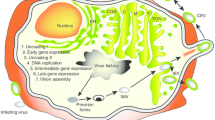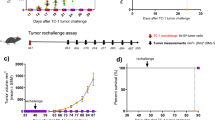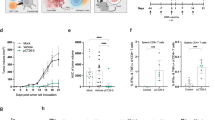Abstract
Survivin is overexpressed by 70–80% of pancreatic cancers, and is associated with resistance to chemotherapy and a poor prognosis. Gemcitabine has been a standard treatment for patients with advanced pancreatic cancer for a decade. Recent reports have demonstrated that gemcitabine treatment attenuates the tumor-suppressive environment by eliminating CD11b+/Gr-1+ myeloid-derived suppressor cells (MDSCs). We hypothesize that a cancer vaccine targeting survivin can achieve enhanced efficacy when combined with gemcitabine. In this study, we tested this hypothesis using modified vaccinia Ankara (MVA) expressing full-length murine survivin. The poorly immunogenic mouse pancreas adenocarcinoma cell line, Pan02, which expresses murine survivin and is syngeneic to C57BL/6, was used for this study. Immunization with MVA-survivin resulted in a modest therapeutic antitumor effect on established Pan02 tumors. When administered with gemcitabine, MVA-survivin immunization resulted in significant tumor regression and prolonged survival. The enhanced vaccine efficacy was associated with decreased CD11b+/Gr-1+ MDSCs. To analyze the survivin-specific immune response to MVA-survivin immunization, we utilized a peptide library of 15mers with 11 residues overlapping from full-length murine survivin. Splenocytes from mice immunized with MVA-survivin produced intracellular γ-interferon in response to in vitro stimulation with the overlapping peptide library. Increased survivin-specific CD8+ T cells that specifically recognized the Pan02 tumor line were seen in mice treated with MVA-survivin and gemcitabine. These data suggest that vaccination with MVA-survivin in combination with gemcitabine represents an attractive strategy to overcome tumor-induced peripheral immune tolerance, and this effect has potential for clinical benefit in pancreatic cancer.






Similar content being viewed by others
References
Jemal A, Siegel R, Ward E et al (2009) Cancer statics, 2009. CA Cancer J Clin 59:225–249
Sohn TA, Yeo CJ, Cameron JL et al (2000) Resected adenocarcinoma of the pancreas-616 patients: results, outcomes, and prognostic indicators. J Gastrointest Surg 4:567–579
Li D, Xie K, Wolff R et al (2004) Pancreatic cancer. Lancet 363:1049–1057
Griffin JF, Smalley SR, Jewell W et al (1990) Patterns of failure after curative resection of pancreatic carcinoma. Cancer 66:56–61
Sperti C, Pasquali C, Piccoli A et al (1997) Recurrence after resection for ductal adenocarcinoma of the pancreas. World J Surg 21:195–200
Burris HA, Moore MJ, Andersen J et al (1997) Improvements in survival and clinical benefit with gemcitabine as first-line therapy for patients with advanced pancreas cancer: a randomized trial. J Clin Oncol 15:2403–2413
Louvet C, Labianca R, Hammel P et al (2005) Gemcitabine in combination with oxaliplatin compared with gemcitabine alone in locally advanced or metastatic pancreatic cancer: results of a GERCOR and GISCAD phase III trial. J Clin Oncol 23:3509–3516
Moore MJ, Goldstein D, Hamm J et al (2007) Erlotinib plus gemcitabine compared with gemcitabine alone in patients with advanced pancreatic cancer: a phase III trial of the National Cancer Institute of Canada Clinical Trials Group. J Clin Oncol 25:1960–1966
Plate JM, Shott S, Harris JE (1999) Immunoregulation in pancreatic cancer patients. Cancer Immunol Immunother 48:270–279
Daikeler T, Maas K, Hartmann JT et al (1997) Weekly short infusions of gemcitabine are not associated with suppression of lymphatic activity in patients with solid tumors. Anticancer Drugs 8:643–644
Plate JM, Plate AE, Shott S et al (2005) Effect of gemcitabine on immune cells in subjects with adenocarcinoma of the pancreas. Cancer Immunol Immunother 54:915–925
Casneuf VF, Demetter P, Boterberg T et al (2009) Antiangiogenic versus cytotoxic therapeutic approaches in a mouse model of pancreatic cancer: An experimental study with multitarget tyrosine kinase inhibitor (sunitinib), gemcitabine and radiotherapy. Oncol Rep 22:105–113
Nowak AK, Robinson BW, Lake RA (2003) Synergy between chemotherapy and immunotherapy in the treatment of established murine solid tumors. Cancer Res 63:4490–4496
Nowak AK, Lake RA, Marzo AL et al (2003) Induction of tumor cell apoptosis in vivo increases tumor antigen cross-presentation, cross-priming rather than cross-tolerizing host tumor-specific CD8 T cells. J Immunol 170:4905–4913
Suzuki E, Kapoor V, Jassar AS et al (2005) Gemcitabine selectively eliminates splenic Gr-1+/CD11b+ myeloid suppressor cells in tumor-bearing animals and enhances antitumor immune activity. Clin Cancer Res 11:6713–6721
Ko HJ, Kim YJ, Kim YS et al (2007) A combination of chemoimmunotherapies can efficiently break self-tolerance and induce antitumor immunity in a tolerogenic murine tumor model. Cancer Res 67:7477–7486
Ito M, Shichijo S, Tsuda N et al (2001) Molecular basis of T cell-mediated recognition of pancreatic cancer cells. Cancer Res 61:2038–2046
Schnurr M, Galambos P, Scholz C et al (2001) Tumor cell lysate-pulsed human dendritic cells induce a T-cell response against pancreatic carcinoma cells: an in vitro model for the assessment of tumor vaccines. Cancer Res 61:6445–6450
Schmitz-Winnenthal FH, Volk C, Z’graggen K et al (2005) High frequencies of functional tumor-reactive T cells in bone marrow and blood of pancreatic cancer patients. Cancer Res 65:10079–10087
Fukunaga A, Miyamoto M, Cho Y et al (2004) CD8+ tumor-infiltrating lymphocytes together with CD4+ tumor-infiltrating lymphocytes and dendritic cells improve the prognosis of patients with pancreatic adenocarcinoma. Pancreas 28:e26–e31
Altieri DC (2008) Survivin, cancer networks and pathway-directed drug discovery. Nat Rev Cancer 8:61–70
Adida C, Crotty PL, McGrath J et al (1998) Developmentally regulated expression of the novel cancer anti-apoptosis gene survivin in human and mouse differentiation. Am J Pathol 152:43–49
Ambrosini G, Adida C, Altieri DC (1997) A novel anti-apoptosis gene, survivin, expressed in cancer and lymphoma. Nat Med 3:917–921
Velculescu VE, Madden SL, Zhang L et al (1999) Analysis of human transcriptomes. Nat Genet 23:387–388
Yamamoto H, Ngan CY, Monden M (2008) Cancer cells survive with survivin. Cancer Sci 99:1709–1714
Altieri DC (2006) Targeted therapy by disabling crossroad signaling networks: the survivin paradigm. Mol Cancer Ther 5:478–482
Andersen MH, Pedersen LO, Capeller B et al (2001) Spontaneous cytotoxic T-cell responses against survivin-derived MHC class I-restricted T-cell epitopes in situ as well as ex vivo in cancer patients. Cancer Res 61:5964–5968
Rohayem J, Diestelkoetter P, Weigle B et al (2000) Antibody response to the tumor-associated inhibitor of apoptosis protein survivin in cancer patients. Cancer Res 60:1815–1817
Xiang R, Mizutani N, Luo Y et al (2005) A DNA vaccine targeting survivin combines apoptosis with suppression of angiogenesis in lung tumor eradication. Cancer Res 65:553–561
Zeis M, Siegel S, Wagner A et al (2003) Generation of cytotoxic responses in mice and human individuals against hematological malignancies using survivin-RNA-transfected dendritic cells. J Immunol 170:5391–5397
Sarela AI, Verbeke CS, Ramsdale J et al (2002) Expression of survivin, a novel inhibitor of apoptosis and cell cycle regulatory protein, in pancreatic adenocarcinoma. Br J Cancer 86:886–892
Kami K, Doi R, Koizumi M et al (2005) Downregulation of survivin by siRNA diminishes radioresistance of pancreatic cancer cells. Surgery 138:299–305
Satoh K, Kaneko K, Hirota M et al (2001) Expression of survivin is correlated with cancer cell apoptosis and is involved in the development of human pancreatic duct cell tumors. Cancer 92:271–278
Espenschied J, Lamont J, Longmate J et al (2003) CTLA-4 blockade enhances the therapeutic effect of an attenuated poxvirus vaccine targeting p53 in an established murine tumor model. J Immunol 170:3401–3407
Daftarian P, Song GY, Ali S et al (2004) Two distinct pathways of immuno-modulation improve potency of p53 immunization in rejecting established tumors. Cancer Res 64:5407–5414
Song GY, Gibson G, Haq W et al (2007) An MVA vaccine overcomes tolerance to human p53 in mice and humans. Cancer Immunol Immunother 56:1193–1205
Harrop R, Connolly N, Redchenko I et al (2006) Vaccination of colorectal cancer patients with modified vaccinia Ankara delivering the tumor antigen 5T4 (TroVax) induces immune responses which correlate with disease control: a phase I/II trial. Clin Cancer Res 12:3416–3424
Corbett TH, Roberts BJ, Leopold WR et al (1984) Induction and chemotherapeutic response of two transplantable ductal adenocarcinomas of the pancreas in C57BL/6 mice. Cancer Res 44:717–726
Tan MC, Goedegebuure PS, Belt BA et al (2009) Disruption of CCR5-dependent homing of regulatory T cells inhibits tumor growth in a murine model of pancreatic cancer. J Immunol 182:1746–1755
Macpherson I, Stoker M (1962) Polyoma transformation of hamster cell clones—an investigation of genetic factors affecting cell competence. Virology 16:147–151
Dialynas DP, Wilde DB, Marrack P et al (1983) Characterization of the murine antigenic determinant, designated L3T4a, recognized by monoclonal antibody GK1.5: expression of L3T4a by functional T cell clones appears to correlate primarily with class II MHC antigen-reactivity. Immunol Rev 74:29–56
Miconnet I, Coste I, Beermann F et al (2001) Cancer vaccine design: a novel bacterial adjuvant for peptide-specific CTL induction. J Immunol 166:4612–4619
Wang Z, La Rosa C, Mekhoubad S et al (2004) Attenuated poxviruses generate clinically relevant frequencies of CMV-specific T cells. Blood 104:847–856
Manuel ER, Wang Z, Li Z et al (2010) Intergenic region 3 of modified vaccinia Ankara is a functional site for insert gene expression and allows for potent antigen-specific immune responses. Virology 403:155–162
Ishizaki H, Song GY, Srivastava T et al (2010) Heterologous prime/boost with p53-based vaccines combined with toll-like receptor stimulation enhances tumor regression. J Immunother 33:609–617
Gallina G, Dolcetti L, Serafini P et al (2006) Tumors induce a subset of inflammatory monocytes with immunosuppressive activity on CD8+ T cells. J Clin Invest 116:2777–2790
Rabinovich GA, Gabrilovich D, Sotomayor EM (2007) Immunosuppressive strategies that are mediated by tumor cells. Annu Rev Immunol 25:267–296
Gabrilovich DI, Velders MP, Sotomayor EM et al (2001) Mechanism of immune dysfunction in cancer mediated by immature Gr-1+ myeloid cells. J Immunol 166:5398–5406
Serafini P, Borrello I, Bronte V (2006) Myeloid suppressor cells in cancer: recruitment, phenotype, properties, and mechanisms of immune suppression. Semin Cancer Biol 16:53–65
Kusmartsev S, Cheng F, Yu B et al (2003) All-trans-retinoic acid eliminates immature myeloid cells from tumor-bearing mice and improves the effect of vaccination. Cancer Res 63:4441–4449
Serafini P, Meckel K, Kelso M et al (2006) Phosphodiesterase-5 inhibition augments endogenous antitumor immunity by reducing myeloid-derived suppressor cell function. J Exp Med 203:2691–2702
Ozao-Choy J, Ma G, Kao J et al (2009) The novel role of tyrosine kinase inhibitor in the reversal of immune suppression and modulation of tumor microenvironment for immune-based cancer therapies. Cancer Res 69:2514–2522
Acknowledgments
The authors thank the staff of the Animal Resource Center at City of Hope for their expert animal handling and assistance in husbandry. Grant support for these studies was from NCI (CA077544 and CA030206) to Don J. Diamond, a minority supplement award to E. Manuel (CA030206S2) and a RAID supplement (CA030206S3) to DJD. Grants from the Riley Foundation and FAMRI also provided partial support for the project to Joshua D. I. Ellenhorn. The COH Cancer Center is supported by CA033572. D. Diamond dedicates this report to the memory of his dear friend, David VP Marks.
Conflict of interest
The authors declare that there are no conflicts of interest in regard to this work.
Author information
Authors and Affiliations
Corresponding author
Additional information
H. Ishizaki and E. R. Manuel contributed equally to this work.
Rights and permissions
About this article
Cite this article
Ishizaki, H., Manuel, E.R., Song, GY. et al. Modified vaccinia Ankara expressing survivin combined with gemcitabine generates specific antitumor effects in a murine pancreatic carcinoma model. Cancer Immunol Immunother 60, 99–109 (2011). https://doi.org/10.1007/s00262-010-0923-0
Received:
Accepted:
Published:
Issue Date:
DOI: https://doi.org/10.1007/s00262-010-0923-0




